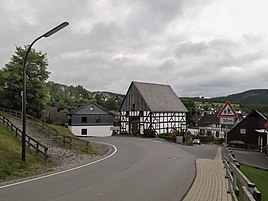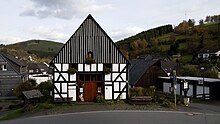Züschen (Winterberg)
|
Züschen
City of Winterberg
Coordinates: 51 ° 9 ′ 10 ″ N , 8 ° 33 ′ 43 ″ E
|
||
|---|---|---|
| Height : | 507 (450-816) m | |
| Residents : | 1590 (June 30, 2019) | |
| Incorporation : | 1st January 1975 | |
| Postal code : | 59955 | |
| Area code : | 02981 | |
|
Location of Züschen in Winterberg |
||
|
Street in Züschen
|
||
Züschen is a district of Winterberg in the Hochsauerlandkreis . The village , known for winter sports, has almost 1640 inhabitants.
geography
Züschen is located in the northeastern Rothaargebirge around 7 km southeast of Winterberg and just under 7 km northwest of Hallenberg . It spreads between 450 and 816 m altitude in the valley of the Nuhne (an Eder tributary), which is created in Züschen by the confluence of the Sonneborn and Ahre . The B 236 runs through the village .
history
Place name
The place name Züschen is derived from the word between, because the village was built between the rivers Sonneborn and Ahre.
Early history
Like many villages in the Sauerland, Züschen probably originated in the 9th century. The first documented mention as far as is known dates from 1243. From 1353 to 1574, the Free County of Züschenau can be proven in the area of Züschen . Its chairmanship had an exemption . The court met at the Siebenahorn free chair. Today's field names such as Free Chair or Bad Wood still bear witness to the court of that time. On the other hand, names like Zwistberg (Streitberg) refer to the formerly controversial border with the County of Wittgenstein .
From 1855 to 1857 the Catholic Church of St. Johannes Baptist was rebuilt on the Ebenau . Probably the oldest house in town, the Schniedes house, was demolished in 1921. In 1989, a medieval fountain was discovered next to the Borg's Barn Museum.
Züschen soldiers in the First World War
Around 180 soldiers from Züschen were deployed in the First World War (1914–1918), 31 of whom died. In 1905 Züschen had 729 inhabitants, in 1925 there were 1,060.
When the war against Russia began in August 1914, the brigade responsible was given the task of setting up a reserve infantry regiment (RIR 81). Many other Züscheners came to the "neighboring" units within the XVIII. Army Corps or XVIII. Reserve Army Corps under.
Züschen in World War II
In the Second World War , 62 Züscheners died as soldiers, most of them on the Eastern Front , or died in captivity.
In March 1945, supports were installed in the cellars of the village and tunnels were driven into the valley slopes, as there was fear of fighting over the ground due to the approaching US troops. On the orders of the party leadership of the NSDAP , anti-tank barriers were erected. On March 29, Wehrmacht soldiers fled from the US soldiers who had moved into Hallenberg. US tanks drove to the anti-tank barrier from the direction of Hallenberg and withdrew. At this point, white flags were already waving at many houses. Only now was the anti-tank barrier occupied and reinforced. The white flags had to be brought down. A representative of the Gauleiter called the Volkssturm , but the men had already fled into the woods. Nine assault guns with parts of the 22nd SS Panzer Training Division rolled up from Winterberg. 22 Germans were killed in night fighting. On March 31st, the rest of the population fled into the woods. US artillery shelling began and many houses were damaged. US infantry bypassed the valley and at the same time tanks attacked the barrier. On April 2nd, US soldiers were able to capture the rest of the village. The Americans were briefly replaced by Belgians until the British occupied the village.
Züschen after 1945
Züschen was an independent municipality in the Hallenberg district until 1974 , when it came to the town of Winterberg on January 1, 1975. The last mayor of Züschen was Karl-Josef Stockhausen. The tourist office and the guest house are now located in the former town hall of Züschen. In 1983 Züschen was national winner (gold) in the competition Our village should be more beautiful (today our village has a future ; see list of winners in the national competition Our village has a future ).
Culture and sights
- Borg's Barn is a two-story half - timbered gabled house from the 18th century. As a "place with past and present" it serves various cultural events: encounters of the village community, cabaret events, exhibitions, puppet theater and readings by authors.
music
- Musikverein Züschen 1910
- The marching band Züschen was founded in 1906.
- Minstrels Federschrey, medieval music group
Associations, interest groups, clubs
- TUS Züschen 1931
- Züschen volunteer fire department
- St. Hubertus Rifle Brotherhood Züschen
- Züschener Böllerrätze (Böllerschützen)
- MGV Sangesfreunde Züschen and his mixed choir department
- BVB - Holteböck fan club - Züschen
- Tourist and local history association
- SGV, Sauerland Mountain Association, Züschen department
- Kolping family Züschen
- Züschen ski club
- Support association for culture, monument preservation and nature conservation in the community of Züschen
- Züschener country women
- Musikverein Züschen 1910
- Züschen minstrel march 1906
- MSC Züschen
- Guard association TUS Züschen
Economy and Transport
Economy: There is a company in Züschen (Küster ACS GmbH) which, among other things, produces 70% of the world's demand for sliding roof cables. There are also several shops, a gas station, hotels, guesthouses and restaurants in the village. There is also a joinery and a shipping company. Until the 1970s, the village was strongly characterized by agriculture. Tourism in winter has now taken on an important form in the village. There is also an Ante-Holz sawmill in the village, one of the largest sawmills in Europe , which in addition to its main plant in Bromskirchen also operates plants in Rottleberode and Poland . With the company JOLA-Johann Lange GmbH, a company for machining technology in the wood and plastic sector is also located in Züschen.
Winter sports: Northeast of the Ziegenhelle ( 815.5 m above sea level ) is the winter sports area Snow World Züschen , and north of the Hackelberg ( 690 m ) there are a small and two large ski jumps , which are no longer used and are also completely overgrown so that they are hard to spot. The area around the ski jump in the "Täler" was cleared again in 2007 by members of the ski club and made visible again.
Transport: The train station Züschen was due to the Nuttlar-Frankenberg railway . Passenger traffic between Winterberg (Westf) and Allendorf (Eder) was stopped on November 14, 1966. This section has now been closed .
Description of the coat of arms
Two smaller coats of arms are depicted on the top right and left of the coat of arms of Züschen. The left coat of arms shows a black cross on a white background; in addition, a red sword is depicted in its right half. The black cross is the coat of arms of the former Electorate of Cologne, to which Züschen belonged for centuries as part of the Electoral Cologne Sauerland. The red sword reminds of the Vote court The small coat of arms on the right is the coat of arms of those von Winter, former ex-exemptions from Züschen. It is divided into two halves: In the left half we see three black tears, which stand for the then Kurköln, the right half is black and yellow checkered (these colors stand for Saxony), because Züschen was then directly on the Electoral Cologne-Saxon border lay, which is why it was given special rights and a neutral and independent free county (free county) formed. Under these two small coats of arms we see the parish church of St. John the Baptist, which is the main symbol of Züschen. Directly below to the left of her we see Borg's barn, which is also a Züschen landmark. Next to the two buildings we see the Ahre on the left and the Sonneborn on the right, which unite at the bottom in the middle of the coat of arms under a red water wheel (water power had a strong economic importance for Züschen since the Middle Ages). The background of the coat of arms is dark green.
This coat of arms is not an official coat of arms.
literature
- Hugo Cramer: The district of Brilon in the Second World War 1939–1945 - reports from many employees from all over the district. Josefs-Druckerei, Bigge 1955.
- Heinrich Dobbener: History of the free county , the community and parish Züschen, Kr. Brilon. Edited by the community of Züschen (Kr. Brilon). Gebr. Zimmermann, Balve (Westphalia) 1957.
- Walter Peis (ed.): Customer and document of a Sauerland village. 750 years of Züschen. Association for the protection of culture, monuments and nature conservation, Züschen / Dortmund 1993.
Web links
- Website Züschen
- Züschen (Winterberg) in the Westphalia Culture Atlas
Individual evidence
- ↑ City of Winterberg: Winterberg in facts and figures , accessed on December 30, 2019
- ^ Walter Peis (ed.): Customer and document of a Sauerland village. 750 years of Züschen . Association for the preservation of culture, monuments and nature conservation, Züschen / Dortmund 1993, p. 292 .
- ^ Josef Rüther: Local history of the Brilon district . Regensberg Verlag, Münster 1956, p. 379 .
- ^ Hugo Cramer: The district of Brilon in the Second World War 1939-1945 . 1955, honor roll section Züschen, p. 196.
- ^ Hugo Cramer: The district of Brilon in the Second World War 1939-1945 . 1955, section Züschen, pp. 98-102.
- ^ Federal Statistical Office (ed.): Historical municipality directory for the Federal Republic of Germany. Name, border and key number changes in municipalities, counties and administrative districts from May 27, 1970 to December 31, 1982 . W. Kohlhammer, Stuttgart / Mainz 1983, ISBN 3-17-003263-1 , p. 332 .
- ↑ Borg's Barn ( Memento from February 26, 2013 in the Internet Archive )
- ↑ [http://www.cdu-winterberg.de/de/partei_und_gliederung/cdu_ortsverbaende/zueschen.php CDU local association Züschen; therein: '' 'Illustration' '' of the coat of arms of Züschen] (link not available)
- ^ Eduard Belke, Alfred Bruns, Helmut Müller: Communal coat of arms of the Duchy of Westphalia, Arnsberg 1986 ISBN 3-87793-017-4




